
The Noctuidae, commonly known as owlet moths, cutworms or armyworms, are the most controversial family in the superfamily Noctuoidea because many of the clades are constantly changing, along with the other families of the Noctuoidea. It was considered the largest family in Lepidoptera for a long time, but after regrouping Lymantriinae, Catocalinae and Calpinae within the family Erebidae, the latter holds this title now. Currently, Noctuidae is the second largest family in Noctuoidea, with about 1,089 genera and 11,772 species. However, this classification is still contingent, as more changes continue to appear between Noctuidae and Erebidae.

Helicoverpa zea, commonly known as the corn earworm, is a species in the family Noctuidae. The larva of the moth Helicoverpa zea is a major agricultural pest. Since it is polyphagous during the larval stage, the species has been given many different common names, including the cotton bollworm and the tomato fruitworm. It also consumes a wide variety of other crops.
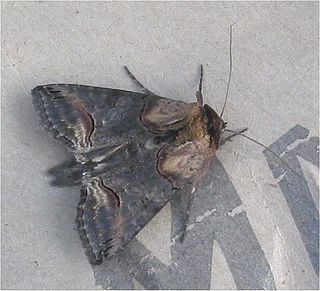
Abrostola triplasia is a moth of the family Noctuidae. It is found across the entire Palearctic realm. Subarctic territories with an average temperature of below 6 °C are an exception. In the warmest and driest regions of the Mediterranean, the Middle East, and the mountains in West and Central Asia, the species occurs only scattered or is entirely lacking.

Eurois occulta, the great brocade or great gray dart, is a moth of the family Noctuidae. It is found in northern and central Europe, North Asia and central Asia to the Pacific Ocean and Japan. Also the northern parts of North America. In addition, it is found in Greenland and Iceland. In the south in northern Spain and on the Balkan peninsula.
Stiria is a genus of moths of the family Noctuidae. The genus was erected by Augustus Radcliffe Grote in 1874.
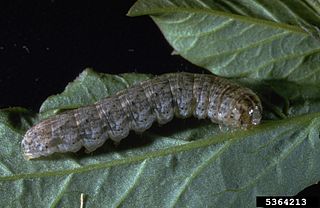
Euxoa messoria, the darksided cutworm or reaper dart, is a moth of the family Noctuidae. The species was first described by Thaddeus William Harris in 1841. It is found from Newfoundland west to Yukon, south to Virginia and Missouri in the east and New Mexico, Arizona and California in the west.
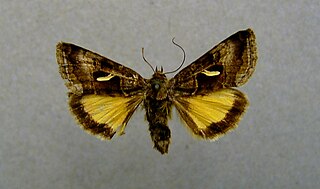
Syngrapha hochenwarthi is a moth of the family Noctuidae. It is found in the Alps, the mountainous areas of Northern Norway and Finland, the Ural mountains, the Balkan, the Caucasus and the Altai mountains.

Catocala junctura, the joined underwing or Stretch's underwing, is an moth in the family Erebidae. The species was first described by Francis Walker in 1858. It is found throughout temperate North America ranging from New York and Pennsylvania west to Montana, Colorado, Oklahoma, Arizona and into Texas, and north to southern Illinois, extreme southern Alberta and Saskatchewan; it has also been recorded west of the Rocky Mountains from California and south-eastern British Columbia. It is typically found near water, where the food plants of its caterpillar larvae grow plentifully.

Raphia frater, the Brother Moth, is a moth of the family Noctuidae. It is found from Nova Scotia west, across the forested regions of Canada to British Columbia, south to Mississippi in the east. The southern limits in the west are uncertain due to confusion with several closely related species or forms.
Anicla forbesi is a moth of the family Noctuidae. It is found from Nova Scotia to western Ontario, south to northern Ohio and Pennsylvania, along the Appalachian Mountains to southwest Virginia and west to northern Michigan, central Wisconsin and northern Minnesota.
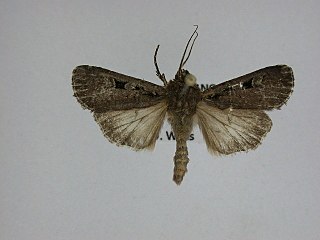
Euxoa tessellata, the tessellate dart or striped cutworm is a moth of the family Noctuidae. It is the most widespread Euxoa-species in North America. It is found from Newfoundland to Alaska, south in the west to California, Arizona, New Mexico, south in the east to Florida. It seems to be absent from Texas and adjacent eastern states.
Aplectoides condita is a moth of the family Noctuidae. It is found across central and southern Canada from Newfoundland to British Columbia. In the east it occurs as far south as northern New Jersey and northern Pennsylvania, west to Michigan and Wisconsin. It is found along the Appalachians in Virginia and North Carolina. In the west it occurs in Idaho and Oregon. Recently it has also been recorded from Tennessee.

Xestia smithii, or Smith's dart, is a moth of the family Noctuidae. The species was first described by Pieter Cornelius Tobias Snellen in 1896. It is found across northern North America from Newfoundland to Alaska. In the eastern United States it occurs from Maine to Virginia and south along the Appalachians to North Carolina. In the west it is found in the Black Hills in western South Dakota and north-eastern Wyoming, in the Rocky Mountains from Montana to New Mexico, south-eastern Arizona, and from Washington to east central California. It has recently been recorded from Tennessee.
Diachrysia aereoides, the dark-spotted looper or lined copper looper, is a moth of the family Noctuidae. The species was first described by Augustus Radcliffe Grote in 1864. It is found in North America from Newfoundland west to northern California. It reaches its southernmost distribution in Great Smoky Mountains National Park.
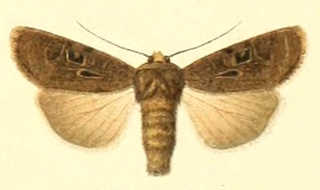
Chersotis andereggii is a moth of the family Noctuidae.

Zale lunifera, the bold-based zale or pine barrens zale, is a moth of the family Noctuidae. The species was first described by Jacob Hübner in 1818. It occurs primarily east and south of the Appalachian Mountains, from southern Maine south to Lee County, Mississippi, Mississippi and Florida. It is not known from south-eastern Virginia or South Carolina, but the species may occur in these regions. Lack of suitable habitat in Maryland and Delaware make occurrence in these states unlikely. It also occurs inland to the mountains of Virginia and Lebanon County, Pennsylvania. In south-eastern Georgia it inhabits open, sandy pine-oak forest.

The Erebidae are a family of moths in the superfamily Noctuoidea. The family is among the largest families of moths by species count and contains a wide variety of well-known macromoth groups. The family includes the underwings (Catocala); litter moths (Herminiinae); tiger, lichen, and wasp moths (Arctiinae); tussock moths (Lymantriinae), including the arctic woolly bear moth ; piercing moths ; micronoctuoid moths (Micronoctuini); snout moths (Hypeninae); and zales, though many of these common names can also refer to moths outside the Erebidae. Some of the erebid moths are called owlets.
Grammia virgo, the virgin tiger moth, is a moth of the family Erebidae. The species was first described by Carl Linnaeus in his 1758 10th edition of Systema Naturae. It is found in North America from Newfoundland south to Florida west to Alberta.
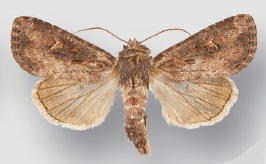
Resapamea passer, the dock rustic moth, is a moth in the family Noctuidae. It is found from central Alberta to northern Arizona in the Rocky Mountain region. In the mid-Continent it ranges from Minnesota and southern Ontario to Oklahoma and North Carolina, reaching the Atlantic Coast from Newfoundland to Maryland. The habitat consists of wetlands.

Metaxaglaea viatica, the roadside sallow moth, is a moth of the family Noctuidae. It is found in North America, where it has been recorded from Alabama, Arkansas, Florida, Georgia, Illinois, Indiana, Kansas, Kentucky, Maine, Maryland, Massachusetts, Michigan, New Hampshire, New Jersey, North Carolina, Ohio, Oklahoma, South Carolina, Tennessee, Texas, Virginia, West Virginia and Wisconsin.














